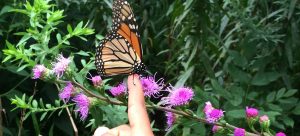 Resources to Learn about Harvesting Milkweed Seeds
Resources to Learn about Harvesting Milkweed Seeds
This post provides links to articles that help us with learning about harvesting and sharing milkweed seeds. Many of the tips and tricks are applicable to other types of seeds.
If you’ve grown milkweed, your plant is probably developing pods. Rose Milkweed (Ascelpias incarnata) might have already opened its pods, but it may not be too late to get a few other pods that are just becoming ripe. Common Milkweed is still maturing as of this post, September 10, 2017.
When can you pick the pod?
Finding the best time is a matter of experience and trial and error. Pick the pod too early, and the seeds won’t be properly developed. Too late, and the seeds will have been carried away by the wind by their tiny “parachutes.”
To test the pod’s readiness, squeeze just slightly, and the seam should become slightly visible, or if the pod has just started to split, it is a perfect time to get the pod. Harvesting the pod at this perfect moment makes cleaning the seeds so much easier than when the pod is completely open.
This site has ideas about how to contain a ripened pod: Harvest Milkweed
What’s the easiest way to clean the seeds?
It’s easiest when you have to tease the pod open. The photos illustrate exactly how to remove seeds from the floss.

How should I store the seed?
This is an important question! The seed needs to be kept in a place that is cool and dry, but not too dry, or the seed can dessicate and become non-viable. Inside the seed is a tiny embryo which is waiting to emerge, and is in a suspended state of life (wild!).
The storage space can’t be too moist or the seeds will get moldy and also become inviable.
The best way to store seed is in a paper envelope or some other breathable container and keep in the refrigerator. Check on a regular basis that they are staying healthy.
When should I plant the seed? What’s the best way to get it to germinate (sprout)?
You can plant the seed now in the fall, and it will wait till after winter and germinate in late spring. Our native seeds have built-in dormancy mechanisms and know exactly when it is a good time to sprout next year.
You can also get a jump on spring and start your seeds in December or January by using the magic of winter-sowing, which means to sow your seeds directly into a container and set outside where they will naturally go through the process of cold-moist stratification (which is using the conditions of winter to break the seeds’ dormancy). Here is an article Deb Quantock McCarey wrote after one of our winter-sowing workshops with Linda Walker: Wintersowing of Native Plants.
Or you can place the seeds onto a moistened paper towel, place in a baggie labeled with date and seed species. Then place the baggie in the refrigerator for 30-60 days. Be sure to check the length of time required because different species of milkweed seeds have different lengths of time needed in cold-moist stratification. Prairie Moon Nursery has a guide. Look up the plant you are stratifying and check the germination code. For instance, if you look up A. incarnata (Rose Milkweed) it has a germination code of C(30). C=cold moist stratification and 30 indicates the number of days. Hover over where it says C(30), and a window pops up to tell you exactly what the code means. It’s a very thoughtful and handy tool!
I have a lot of seed. How can I share it?
We are planning on having a celebration in November 2017 (would you like to help us organize? Send us a note) and would love to have a seed sharing opportunity.
Monarch Watch also appreciates donations of seeds from across the U.S. They use the seeds to grow local eco-type milkweeds for restoration projects or for learning institutions. Monarch Watch Guide about Collecting and Sending Seed
If you have the seed cleaned and labeled, you can donate it to us, and we will share throughout the year at events.


